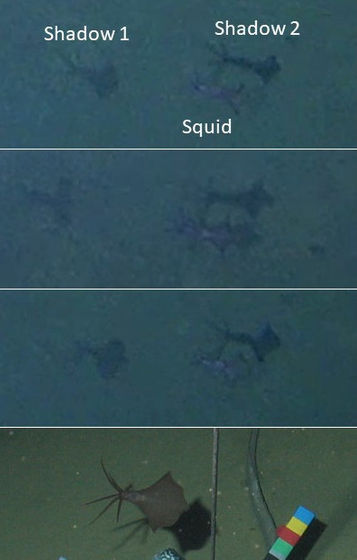Discovering the first living squid in the mysterious world's deepest place 'ultra-deep sea', during the exploration of a destroyer during World War II

A research team searching for a destroyer that sank during World War II at the bottom of the Philippine Sea reported that it had successfully found a squid that swims in the deepest waters to date.
Hadal cephalopods: first squid observation (Oegopsida, Magnapinnidae, Magnapinna sp.) And new records of finned octopods (Cirrata) at depths> 6000 m in the Philippine Trench | SpringerLink
World's deepest-dwelling squid spotted 20,000 feet under the sea | Live Science
https://www.livescience.com/worlds-deepest-squid-philippine-trench
This time, the squid that lives in the deepest place so far was found by a research team that was investigating the sinking site of the American destroyer USS Johnston , which is also called ' the ship that sinks in the deepest place in the world'. Using a manned submersible, a research team investigating USS Johnston sinking in the Philippine Sea discovered a living squid at the bottom of the sea at a depth of 6212 meters.
The position of the submersible was too high to shoot a clear image, but the research team who was able to see features such as very large fins and a unique way of swimming found the squid as a member of the Mizuhiki squid. I estimated. In addition, although Magnapinna pacifica has very long legs, the individual discovered by the research team has relatively short legs, so it is still highly likely that it is a young fish. Magnapinna pacifica was previously found in the sea at a depth of about 4735 meters, but this time it is the deepest record that shortens the record by 1477 meters.
Below is a photo of Magnapinna pacifica previously taken elsewhere by Alan Jamison, the lead author of the paper reporting this discovery.

by Caladan oceanic and Alan Jamieson
In addition, the research team discovered four Cirrate octopus , also known as 'dumbodaco', at depths of 6212-6224 meters, with large fins resembling elephant ears. This is the second time that Cirrate octopus has been discovered in such a deep sea, and it is as valuable a discovery record as the case of Magnapinna pacifica.
Michael Vecchione, a co-author of the paper and a zoologist at the National Oceanic and Atmospheric Administration (NOAA), said, 'This dive shows that multiple species of cephalopods can live in the upper part of really deep trenches. I said.
The magnapinna pacifica was also photographed in November 2021, and if you read the following article, you can clearly see the strangely shaped magnapinna pacifica, which is described as 'like an alien'.
An image of a living adult of the deep-sea squid 'Mizuhiki squid' that looks like a Martian is now available --GIGAZINE

Related Posts:
in Creature, Posted by log1l_ks






